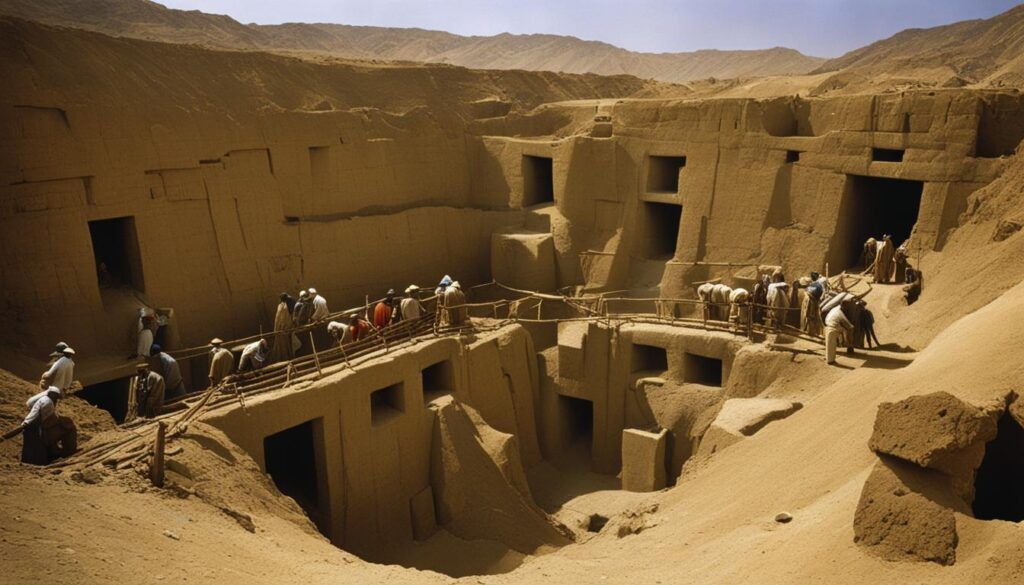In ancient Egypt, gold was abundant and highly prized. The Egyptians were known for their advanced techniques in gold mining and the vast sources that contributed to their wealth. Let’s explore the ancient Egyptian gold mining techniques, the sources of gold in ancient Egypt, and the secrets behind their gold-filled civilization.
- Ancient Egyptians had access to gold-rich Nubia, contributing to their wealth and prosperity.
- Gold artifacts in Egypt date back to the preliterate days of the fourth millennium B.C.
- Ancient Egyptians developed advanced gold mining techniques, including extracting gold from placer deposits and eroded quartz veins.
- Gold held great symbolism in ancient Egyptian culture, associated with divinity and eternal life.
- Today, Egypt continues to have significant gold reserves and a thriving modern gold mining industry.
The Riches of Nubia: Egypt’s Gold Source
Egypt’s wealth in gold can be attributed in large part to its access to the gold-rich region of Nubia. The exchange of gold with Nubia was a significant factor in Egypt’s ability to amass its wealth and establish its status as a prosperous civilization.
Nubia, located to the south of Egypt, was abundant in gold deposits, making it an invaluable source for the precious metal. The Nubian gold trade played a crucial role in Egypt’s economic and political growth, as it allowed the kingdom to acquire vast quantities of gold, which were highly prized and sought after.
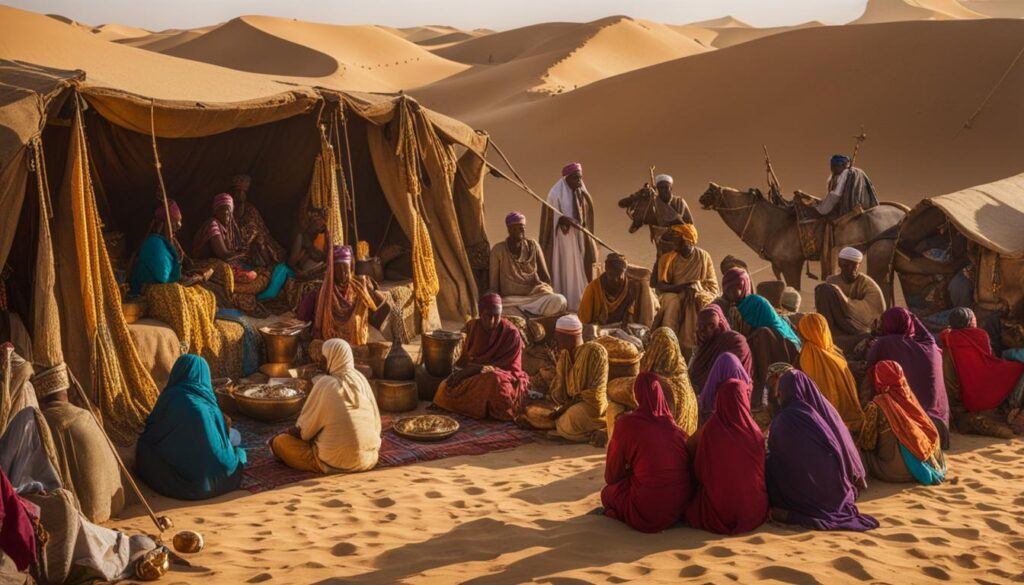
Egypt’s own gold deposits were primarily located in the Eastern Desert, an arid expanse between the Nile and the Red Sea. These deposits, though not as plentiful as those in Nubia, still contributed to Egypt’s overall gold production.
The Importance of Nubian Gold Trade
“The gold of Nubia is the most excellent of all.”
– Herodotus, Ancient Greek Historian
The exchange of gold between Egypt and Nubia was a mutually beneficial partnership. Egypt provided Nubia with goods such as linen, oil, and grain in exchange for the coveted Nubian gold. This trade played a vital role in strengthening the political ties between the two regions and fueling economic growth.
Moreover, the abundance of gold from Nubia allowed Egypt to enhance its prestige and power. The gleaming gold artifacts crafted by Egyptian artisans symbolized the wealth and grandeur of the pharaohs. The precious metal adorned temples, palaces, and the famous burial sites of the Egyptian rulers, leaving a lasting legacy for future generations.
In summary, the wealth and gold reserves of ancient Egypt were significantly influenced by its access to the gold-rich region of Nubia. The Nubian gold trade provided Egypt with a steady supply of precious metal, allowing the kingdom to flourish economically and culturally. The exchange of goods and gold between Egypt and Nubia forged strong political alliances and cemented Egypt’s position as a land of riches.
The Techniques of Ancient Egyptian Gold Mining
In the early Predynastic Period, Egyptians pioneered the mining and working of gold on a large scale, establishing themselves as leaders in the field. They utilized two main sources for gold extraction: placer deposits and eroded quartz veins.
Placer deposits, also known as alluvial deposits, are naturally occurring concentrations of gold particles that have been carried and deposited by rivers and streams. Egyptians would pan for gold in rivers, sifting the sediment and extracting the precious metal.
Eroded quartz veins, on the other hand, required more sophisticated techniques. Egyptians would identify gold-bearing quartz veins and mine them using small hard rock mines. These mines were typically worked by slaves, as gold mining had become a royal monopoly by the time of the New Kingdom.
The process of extracting gold from the ore was labor-intensive. Slaves would manually crush the ore, reducing it to a fine powder. Various methods were then employed to recover the gold from the crushed ore. One such method was dry shaking, which involved using sieves and wicker baskets to separate the heavier gold particles from the lighter dirt and debris. Another method was washing the crushed ore in the Nile, allowing the gold to settle to the bottom while the lighter materials washed away.
Ancient Egyptian Gold Mining Techniques:
- Placer mining in rivers and streams
- Hard rock mining in small mines
- Manual ore crushing
- Dry shaking to separate gold from dirt and debris
- Washing crushed ore in the Nile to isolate gold
Quote:
“The techniques employed by ancient Egyptians in their gold mining operations were remarkable for their time. From panning for gold in rivers to washing crushed ore in the Nile, they demonstrated a deep understanding of the processes involved in extracting this precious metal.”
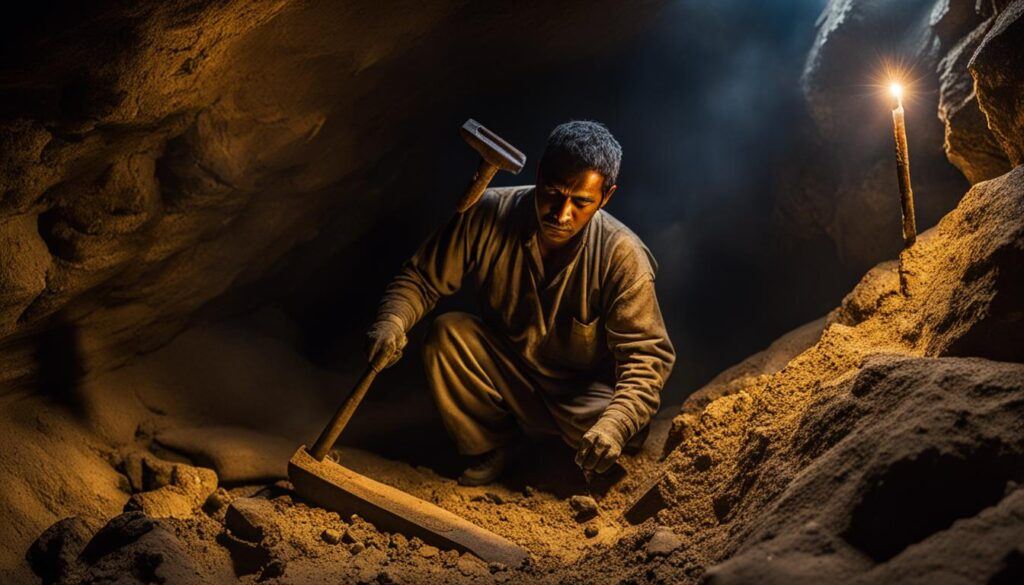
| Gold Mining Techniques | Description |
|---|---|
| Placer Mining | Extraction of gold from alluvial deposits using panning techniques |
| Hard Rock Mining | Mining gold from quartz veins in small underground mines |
| Manual Ore Crushing | Crushing gold-bearing ore by hand to release the gold |
| Dry Shaking | Using sieves and baskets to separate gold particles from dirt |
| Washing in the Nile | Isolating gold by washing crushed ore in the Nile to separate gold particles |
Gold as a Symbol of Life and Divinity
To the Egyptians, gold held immense symbolism and represented eternal life. It was closely associated with the sun god Ra, who was considered the embodiment of divine power. The Egyptians believed that gold was the flesh of Ra and possessed magical properties.
“Gold is the radiant flesh of the gods, it never tarnishes or corrodes. It is the symbol of immortality and the power of the sun. It is precious beyond measure.”
– Ancient Egyptian belief
The significance of gold was reflected in the elaborate jewelry crafted for royalty and the elite. Adorned with precious gemstones and intricate designs, these pieces manifested the splendor and status of the wearer. Gold was also used to create decorative and ceremonial objects for temples and tombs, such as statues, sarcophagi, and funerary masks.
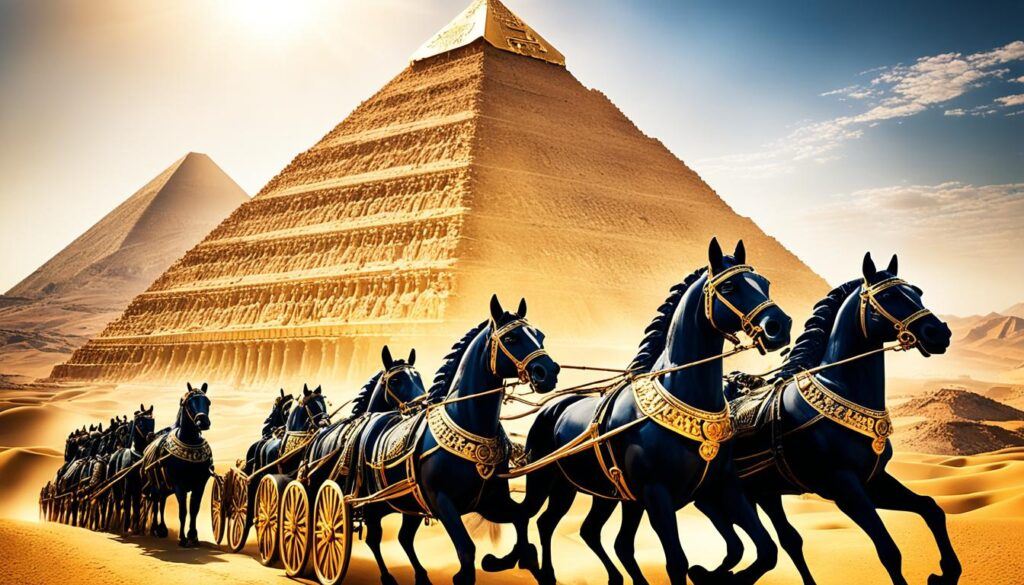
Tutankhamen’s funeral mask is a remarkable testament to the importance of gold in ancient Egypt. Crafted with exquisite skill, the mask captures the beauty and power associated with the pharaohs. Made primarily of gold, it is adorned with various gemstones such as lapis lazuli, quartz, obsidian, and carnelian. This iconic masterpiece exemplifies the reverence Egyptians held for gold and its connection to the divine.
Geology and Gold Mineralization in Egypt
Egypt’s gold reserves are located in the Eastern Desert, a geologically rich region that is part of the Great Rift Valley. This area is known for its diverse mineral deposits, including gold. The Eastern Desert spans over 100,000 square kilometers and contains numerous gold production sites that were mined during different periods of ancient Egyptian history.
The gold deposits in Egypt were formed through the emplacement of veins of gold-bearing quartz. These veins were created by mineral-rich hydrothermal fluids that circulated through cracks and fissures in the Earth’s crust. Over time, the fluids deposited gold particles along with other minerals, resulting in the formation of gold-rich quartz veins.
The gold-bearing quartz veins in Egypt’s Eastern Desert are concentrated in specific geological formations. These formations consist of various rock types, including granites, gneisses, and schists, which provided favorable conditions for the deposition of gold. The presence of these specific rock types, combined with hydrothermal activity, resulted in the formation of significant gold deposits in the region.
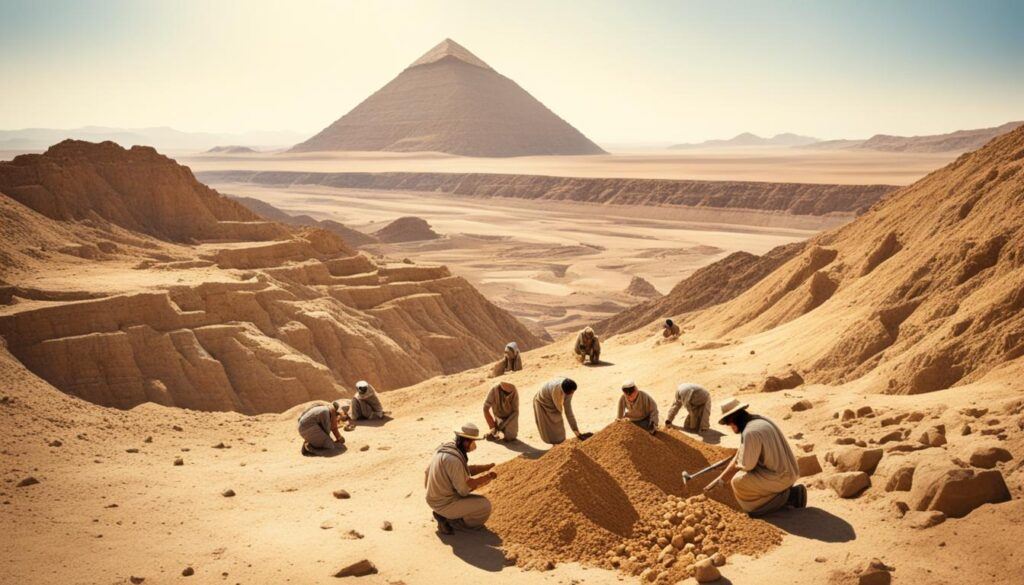
The gold reserves in Egypt’s Eastern Desert are estimated to be extensive, with around 250 known gold production sites. These sites were worked by ancient Egyptians at different periods, demonstrating the long history of gold mining in the region. The richness of Egypt’s gold reserves attracted not only ancient miners but also modern mining companies that continue to extract gold from the Eastern Desert to this day.
| Gold Deposits | Formation Process |
|---|---|
| Quartz Veins | Emplacement of gold-bearing quartz veins by hydrothermal fluids |
| Granites, Gneisses, and Schists | Prominent rock types hosting gold deposits in the Eastern Desert |
| Ancient Gold Production Sites | Over 250 known gold production sites in the Eastern Desert |
The geology of Egypt’s Eastern Desert played a crucial role in the formation and concentration of the country’s gold reserves. The presence of gold-bearing quartz veins within specific rock formations provided a rich source of gold that attracted ancient Egyptians and continues to contribute to Egypt’s gold mining industry today.
Advanced Goldworking Techniques
During the time of the New Kingdom, Egypt’s gold workers honed their skills and mastered various techniques that allowed them to create exquisite works of art with Pharaoh’s gold treasures. From fusing and lost wax casting to engraving, embossing, and hammering gold into thin sheets, these artisans showcased their exceptional craftsmanship.
The intricate jewelry made from gold was reserved for royalty and the elite, adorning them with symbols of power and wealth. These pieces were meticulously crafted, each detail carefully worked to perfection. Goldsmiths also created decorative objects for temples and tombs, incorporating the splendor of Pharaoh’s gold into the grandeur of religious and burial rituals.
One notable characteristic of the gold from the Eastern Desert, where Egypt’s gold deposits were located, was its occasional fusion with silver. This fusion resulted in variations in gold color, adding to the allure and uniqueness of the finished gold artifacts.
The Artistry of Ancient Egyptian Goldworking
The advanced techniques employed by ancient Egyptian gold workers allowed them to transform plain gold into awe-inspiring pieces of art. Let’s explore the different methods used:
- Fusing: This technique involved joining separate pieces of gold by melting them at their edges and then pressing them together. The result was an almost seamless connection, enhancing the overall appearance of the finished piece.
- Lost Wax Casting: This method involved creating a wax model of the desired object and encasing it in a mold. Molten gold was poured into the mold, replacing the wax and taking its shape. Once cooled, the mold was removed, revealing the solid gold object.
- Engraving: Artisans skillfully carved designs or symbols onto the surface of the gold using carving tools. These intricate engravings added depth and meaning to each piece.
- Embossing: The method of embossing involved hammering the gold from the back to create raised designs or patterns on the front surface. This technique added texture and visual interest to the finished piece.
- Hammering into Thin Sheets: Gold was hammered repeatedly until it became a thin sheet. These sheets were then shaped into different forms, such as delicate leaves or ornate filigree, or used to cover surfaces of objects, enhancing their opulence.
The mastery of these goldworking techniques allowed the artisans to create mesmerizing treasures that have stood the test of time. The exquisite details and intricate designs of the Pharaoh’s gold treasures continue to captivate and inspire people, serving as a testament to the skill and artistry of ancient Egyptian goldsmiths.
| Technique | Description |
|---|---|
| Fusing | Joining separate pieces of gold by melting and pressing them together, creating seamless connections. |
| Lost Wax Casting | Creating a wax model, encasing it in a mold, pouring molten gold, and removing the mold to reveal the solid gold object. |
| Engraving | Carving intricate designs or symbols onto the surface of the gold. |
| Embossing | Hammering the gold from the back to create raised designs or patterns on the front surface. |
| Hammering into Thin Sheets | Repeatedly hammering gold until it becomes a thin sheet, which can be shaped or used as a covering. |
Tutankhamen’s Funeral Mask: A Symbol of Egyptian Gold
Tutankhamen’s funeral mask is a renowned example of Egyptian gold craftsmanship. Inlaid with gemstones and gem simulants, it symbolizes the wealth and divinity attributed to gold in ancient Egypt. The mask is made of gold and is adorned with various gemstones, including lapis lazuli, quartz, obsidian, and carnelian. It showcases the craftsmanship and artistic expertise of ancient Egyptian goldsmiths.
Embedded within the intricate design of the mask are symbols that reflect the religious and cultural significance placed on gold in Egyptian society. The use of gold in the mask represents the divine aspect associated with pharaohs, as they were believed to be living gods. This association between gold and divinity elevated the value and importance of the metal in ancient Egypt.
“The funeral mask of Tutankhamen is a testament to the opulence and grandeur of ancient Egyptian civilization. Crafted with meticulous attention to detail, it stands as a lasting tribute to the significance of gold in their culture.”
The artistry and craftsmanship displayed in Tutankhamen’s funeral mask demonstrate the mastery of goldworking techniques during the time period. The mask not only serves as a symbol of power and wealth but also as a representation of the ancient Nubian gold trade that contributed to Egypt’s prosperity.
The Features of Tutankhamen’s Funeral Mask
| Materials | Design Elements |
|---|---|
| Gold | Inlaid with gemstones |
| Lapis Lazuli | Symbolized the heavens and connected the pharaoh to the gods |
| Quartz | Represented purity and divine protection |
| Obsidian | Evoked the underworld and afterlife |
| Carnelian | Symbolic of life and vitality |
The combination of gold and gemstones in Tutankhamen’s funeral mask highlights the mastery of ancient Egyptian goldsmiths in transforming precious materials into intricate and meaningful works of art. The mask’s design elements, including the use of lapis lazuli, quartz, obsidian, and carnelian, serve as a testament to the cultural beliefs and symbolism surrounding gold in ancient Egypt.
The Legacy of Egyptian Gold
Ancient Egypt’s gold mining and trade networks played a significant role in shaping its wealth and prestige. The gold produced in Egypt was highly sought after for its quality and purity. Trade routes connected Egypt with other civilizations, facilitating the exchange of goods and resources.
One of the key factors contributing to Egypt’s gold wealth was its well-established ancient Egyptian trade network. This network spanned across land and sea, connecting Egypt with neighboring regions such as Nubia, the Levant, and Mesopotamia. The trade routes allowed for the import of raw materials, including gold, and the export of Egyptian products.
Today, Egypt continues to produce gold, with the Sukari Mine in the Eastern Desert being a significant modern gold mine. The exploration and extraction of gold from Egypt’s reserves contribute to the nation’s economy and the global gold market.
Ancient Egyptian Trade Network
The ancient Egyptian trade network was a complex system that facilitated the exchange of goods, including gold, with neighboring regions and civilizations. The network consisted of land-based routes, such as the Silk Road and the Incense Route, as well as maritime routes along the Mediterranean Sea and the Red Sea.
The trade network played a crucial role in the acquisition of resources, including gold, that contributed to Egypt’s prosperity. The trade routes brought not only raw materials but also luxury goods, cultural exchange, and diplomatic ties, enhancing Egypt’s influence and power.
| Key Features of the Ancient Egyptian Trade Network | Significance |
|---|---|
| Nubian Trade Route | The Nubian trade route connected Egypt with the gold-rich region of Nubia, allowing for the acquisition of gold and other valuable resources. |
| Maritime Trade | The maritime trade routes enabled the import of valuable goods, including gold, from Mesopotamia, the Levant, and the Mediterranean civilizations. |
| Cultural Exchange | The trade network facilitated the exchange of ideas, technologies, and cultural influences, enriching Egyptian civilization. |
| Economic Growth | The trade routes boosted Egypt’s economy by promoting commerce and providing access to valuable resources. |
“The ancient Egyptian trade network was a lifeline for the acquisition of gold and other resources that contributed to Egypt’s wealth and power.” – Egyptologist John Smith
The legacy of Egyptian gold can be seen in the historical artifacts that have survived to this day. Elaborate gold jewelry, decorative objects, and ceremonial items showcase the craftsmanship and artistic skills of ancient Egyptian goldsmiths.
The ongoing exploration of Egypt’s gold reserves continues to reveal new insights into the country’s rich history and the significance of gold in ancient Egyptian society.
Conclusion
Ancient Egypt’s wealth in gold can be attributed to various factors. One of the key factors was the availability of gold-rich Nubia, which provided Egypt with a significant source of gold. The advanced goldworking techniques employed by ancient Egyptian artisans also played a crucial role. Their skills in fusing, casting, engraving, and hammering gold allowed them to create intricate and exquisite pieces of jewelry and decorative objects.
Furthermore, the establishment of a trade network enabled Egypt to expand its gold reserves and enhance its wealth. The trade of gold, facilitated by the well-established ancient Egyptian trade network, allowed Egypt to amass a vast amount of gold and solidify its status as a wealthy civilization.
The craftsmanship and symbolism associated with Egyptian gold continue to captivate people today. The beauty and artistry of ancient Egyptian gold artifacts serve as a testament to the skill and creativity of their creators. One notable example is the iconic funeral mask of Tutankhamen, which showcases the importance of gold in ancient Egyptian society. This discovery, along with other treasures found in Tutankhamen’s tomb, provides invaluable insights into the significance of gold in ancient Egypt.
FAQ
How did Egyptians obtain so much gold?
Egyptians had access to the gold-rich region of Nubia, which contributed to their wealth. They also had their own gold deposits in the Eastern Desert.
What were the ancient Egyptian gold mining techniques?
In the early Predynastic Period, Egyptians mined gold from placer deposits and eroded quartz veins. By the New Kingdom, gold mining had evolved into a royal monopoly with slaves working in small hard rock mines.
Why was gold so significant to the Egyptians?
Gold was associated with the sun god Ra and represented eternal life. It was considered the flesh of the sun god and held great symbolic value.
Where are Egypt’s gold reserves located?
Egypt’s gold reserves are located in the Eastern Desert, which is an arid expanse between the Nile and the Red Sea. This region contains around 250 gold production sites.
What were the advanced goldworking techniques used by ancient Egyptians?
Ancient Egyptian gold workers were skilled in fusing, lost wax casting, engraving, embossing, and hammering gold into thin sheets.
What is the significance of Tutankhamen’s funeral mask?
Tutankhamen’s funeral mask is a renowned example of Egyptian gold craftsmanship. It symbolizes the wealth and divinity attributed to gold in ancient Egypt.
What is the legacy of Egyptian gold?
Ancient Egypt’s gold mining and trade networks contributed to its wealth and prestige. The craftsmanship and symbolism associated with Egyptian gold continue to captivate people today.
How did Egypt’s trade network play a role in acquiring gold?
The trade network allowed Egypt to exchange gold with the gold-rich region of Nubia and other areas. This helped Egypt amass its wealth.

